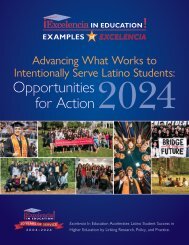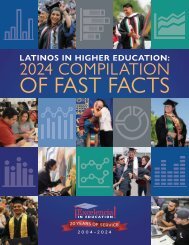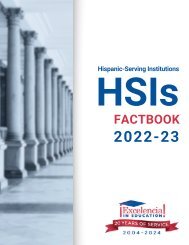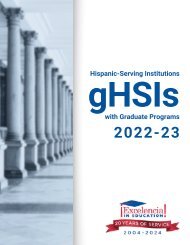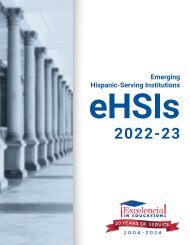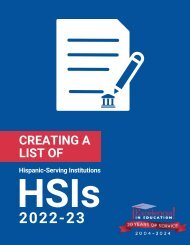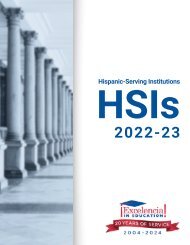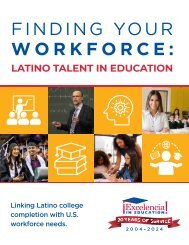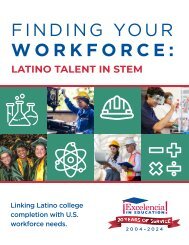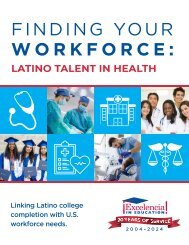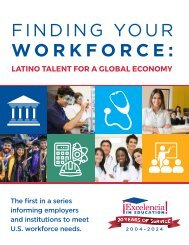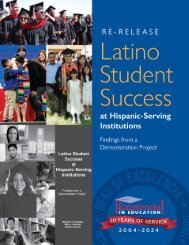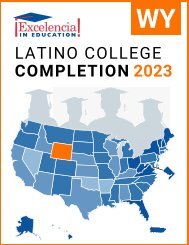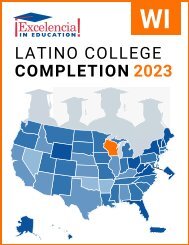Latino College Completion 2023: Montana
Create successful ePaper yourself
Turn your PDF publications into a flip-book with our unique Google optimized e-Paper software.
MT
LATINO COLLEGE COMPLETION:<br />
MONTANA – <strong>2023</strong><br />
For the U.S. to regain the top ranking in the world for college degree<br />
attainment, <strong>Latino</strong>s will need to earn 6.2 million degrees by 2030. 1<br />
FAST FACTS<br />
STATE RANKING:<br />
<strong>Montana</strong> had the 45th largest<br />
<strong>Latino</strong> population in the U.S.<br />
K-12 POPULATION:<br />
In <strong>Montana</strong>, 7% of the K-12<br />
population was <strong>Latino</strong>. 2<br />
POPULATION:<br />
In <strong>Montana</strong>, 4% of the population<br />
was <strong>Latino</strong>. 2<br />
MEDIAN AGE:<br />
The median age<br />
of Hispanics in<br />
<strong>Montana</strong> was 25,<br />
compared to 42<br />
for White non-<br />
Hispanics. 2<br />
25<br />
Hispanics<br />
42<br />
White<br />
non-Hispanics<br />
ENROLLMENT:<br />
In <strong>Montana</strong>, 18% of Hispanics<br />
(ages 18 to 34) were enrolled in higher<br />
education, compared to 17% of<br />
White non-Hispanics. 2<br />
DEGREE ATTAINMENT:<br />
In <strong>Montana</strong>, 28% of Hispanic<br />
adults (25 and older) had earned an<br />
associate degree or higher, compared to<br />
45% of White non-Hispanic adults. 2<br />
Hispanic Adults = 2.8 of 10<br />
To reach the degree attainment goal by 2030, the U.S. can: close<br />
the degree completion gap by accelerating <strong>Latino</strong> completion while<br />
increasing for all students and scale up programs and initiatives that<br />
work for <strong>Latino</strong>, and all, students. The following demographics,<br />
institutional data, and practices inform <strong>Latino</strong> degree attainment.<br />
ENROLLING: Top 5 Institutions (Hispanic Undergraduates) in <strong>Montana</strong>, 2021-22<br />
Institution<br />
Sector<br />
Grand<br />
Total<br />
NOTE: We use the terms <strong>Latino</strong> and Hispanic interchangeably in this factsheet.<br />
Hispanic<br />
Total<br />
Source: Excelencia in Education analysis using U.S. Department of Education, National Center for<br />
Education Statistics (NCES), Integrated Postsecondary Education Data System (IPEDS), 2021 Fall<br />
Enrollment, Graduation Rates Survey and Institutional Characteristics Survey.<br />
%<br />
Hispanic<br />
1 <strong>Montana</strong> State University Public, 4-year 14,329 745 5%<br />
2 The University of <strong>Montana</strong> Public, 4-year 7,026 439 6%<br />
3 <strong>Montana</strong> State University Billings Public, 4-year 2,818 183 6%<br />
Private not-forprofit,<br />
4-year<br />
4 Rocky Mountain <strong>College</strong><br />
807 72 9%<br />
5 The University of <strong>Montana</strong>-Western Public, 4-year 1,283 62 5%<br />
ASSOCIATE DEGREES: Top 5 Institutions Awarding to Hispanics in <strong>Montana</strong>, 2020-21<br />
Institution<br />
Sector<br />
Grand Hispanic %<br />
Total Total Hispanic<br />
1 <strong>Montana</strong> State University Billings Public, 4-year 220 20 9%<br />
2 The University of <strong>Montana</strong> Public, 4-year 253 15 6%<br />
Great Falls <strong>College</strong> <strong>Montana</strong> State<br />
3 University<br />
Public, 2-year 214 14 7%<br />
4 <strong>Montana</strong> State University Public, 4-year 115 9 8%<br />
5 Helena <strong>College</strong> University of <strong>Montana</strong> Public, 2-year 168 8 5%<br />
BACHELOR DEGREES: Top 5 Institutions Awarding to Hispanics in <strong>Montana</strong>, 2020-21<br />
Institution<br />
Sector<br />
Grand<br />
Total<br />
Hispanic<br />
Total<br />
%<br />
Hispanic<br />
1 <strong>Montana</strong> State University Public, 4-year 2,572 98 4%<br />
2 The University of <strong>Montana</strong> Public, 4-year 1,263 60 5%<br />
3 <strong>Montana</strong> State University Billings Public, 4-year 408 21 5%<br />
Private not-forprofit,<br />
4-year<br />
4 Carroll <strong>College</strong><br />
254 10 4%<br />
5 The University of <strong>Montana</strong>-Western Public, 4-year 189 8 4%<br />
White Adults = 4.5 of 10<br />
1 Projections to 2030: Excelencia in Education. (2020). Ensuring America’s Future: Benchmarking <strong>Latino</strong><br />
<strong>College</strong> <strong>Completion</strong> to 2030. Excelencia in Education. Washington, D.C.<br />
2 U.S. Census Bureau, 2021 American Community Survey 1-Year Estimates
<strong>Montana</strong> Gap in Degree <strong>Completion</strong><br />
Closing the degree completion gap can be tracked<br />
by the 4 measures shown below. Alone, none<br />
of these measures capture the entire “story” of<br />
degree completion. However, in combination,<br />
they provide a useful picture of the gap in degree<br />
attainment between Hispanic and White non-<br />
Hispanic cohorts in a single year.<br />
Graduation Rate — Total percentage of students<br />
who graduated within 150% of normal time for<br />
first-time, full-time freshmen. This incorporates<br />
students that graduated in 3 years at two-year<br />
institutions, or in 6 years at four-year institutions.<br />
Transferred to Another Institution —<br />
Percentage of students that transferred to another<br />
institution and did not complete a degree.<br />
Still Enrolled — Percentage of students that are<br />
still enrolled at the point of 150% normal time to<br />
completion.<br />
No Longer Enrolled — Percentage of students<br />
that are no longer enrolled at the point of 150%<br />
normal time to completion.<br />
At two-year institutions, Hispanics’<br />
graduation rate was 26%-points<br />
lower than that of their White<br />
non-Hispanic peers in <strong>Montana</strong>.<br />
TWO-YEAR INSTITUTIONS<br />
3%<br />
38%<br />
21%<br />
38%<br />
WHITE<br />
-26%<br />
75%<br />
4%<br />
8%<br />
12%<br />
HISPANIC<br />
DEGREE OUTCOMES<br />
■ No Longer Enrolled<br />
■ Still Enrolled<br />
■ Transferred to<br />
Another Institution<br />
■ Graduation Rate<br />
*Percentages may not add up to 100% due to rounding.<br />
At four-year institutions, Hispanics’<br />
graduation rate was 15%-points<br />
lower than that of their White<br />
non-Hispanic peers in <strong>Montana</strong>.<br />
FOUR-YEAR INSTITUTIONS<br />
WHITE<br />
-15%<br />
HISPANIC<br />
NOTE: Outcomes shown are for students at two-year institutions who started in Fall 2018, and<br />
for students at four-year institutions who started in Fall 2015.<br />
Source: Excelencia in Education analysis using the U.S. Department of Education, National<br />
Center for Education Statistics (NCES), Integrated Postsecondary Education Data System, 2021<br />
Graduation Rates Survey and the Institutional Characteristics Survey.<br />
3%<br />
41%<br />
5%<br />
51%<br />
56%<br />
6%<br />
36%<br />
2%<br />
Examples of What Works for <strong>Latino</strong> Students<br />
There are institutions showing success in enrolling, retaining, and graduating <strong>Latino</strong> students. The following are examples of<br />
programs across the country with evidence of effectiveness in serving <strong>Latino</strong> students nominated for Examples of Excelencia.<br />
Preparing Underrepresented Educators to Realize their<br />
Teaching Ambitions (PUERTA) Project at Sonoma State<br />
University (SSU) has three primary goals: Increase Hispanic and<br />
Latina/o student persistence and graduation rates, increase the<br />
number of Hispanic and <strong>Latino</strong> students who earn a teaching<br />
credential, and increase the number of students who transfer to<br />
SSU from a two-year Hispanic-Serving Institution. There is a high<br />
need for educators of color in California, specifically in the field of<br />
bilingual education. PUERTA aims to increase teachers of color who<br />
are also linguistically competent. PUERTA implemented the following<br />
activities at SSU that focus on achieving project goals such as<br />
implementing a continuum of academic and student support services,<br />
Summer Bridge programming, outreach and career development<br />
support, improving first-year Latinx students’ access to General<br />
Education (GE) courses, and providing professional development<br />
engagement for aspiring teachers.<br />
Between 2019-20 and 2020-21:<br />
• Latinx students transferring to SSU from a community college<br />
increased 40% from 234 to 327.<br />
• Enrollment in a SSU credential program increased from 15 to 52 and<br />
earning a teaching credential at SSU increased from 6 to 34.<br />
• 50% of Latinx students completed 30 units in their first year of<br />
college, compared to 59% of PUERTA students.<br />
• Latinx students increased their retention from 83% to 90%.<br />
• 100% of transfer students returned.<br />
For more information on institutional programs improving <strong>Latino</strong> student success in higher education, access Excelencia in<br />
Education’s Growing What Works database at http://www.edexcelencia.org/growing-what-works<br />
ENSURING AMERICA’S FUTURE BY INCREASING LATINO COLLEGE COMPLETION • WWW.EDEXCELENCIA.ORG




